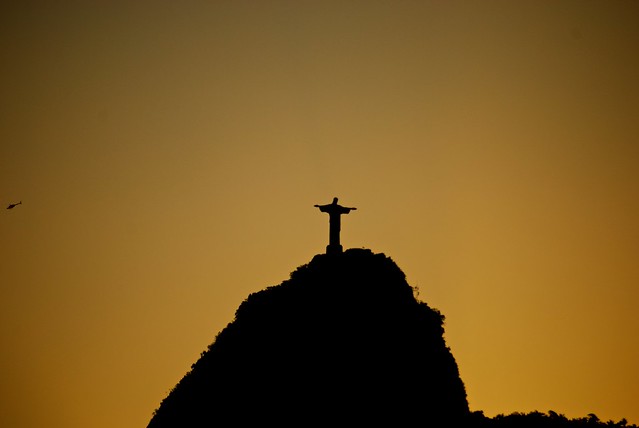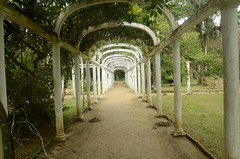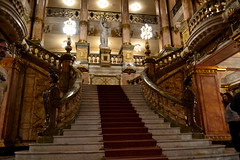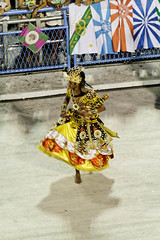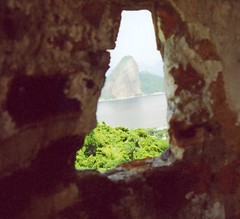Rio de Janeiro
Rio de Janeiro (Portuguese: [ˈʁi.u d(ʒi) ʒɐˈne(j)ɾu]; literally 'River of January'), or simply Rio, is the capital of the state of the same name, Brazil's third most populous state, and the second most populous city in Brazil, after São Paulo. Listed by the GaWC as a beta global city, Rio de Janeiro is the sixth most populous city in the Americas. Part of the city has been designated as a World Heritage Site, named "Rio de Janeiro: Carioca Landscapes between the Mountain and the Sea", on 1 July 2012 as a Cultural Landscape.
Founded in 1565 by the Portuguese, the city was initially the seat of the Captaincy of Rio de Janeiro, a domain of the Portuguese Empire. In 1763, it became the capital of the State of Brazil, a state of the Portuguese Empire. In 1808, when the Portuguese Royal Court moved to Brazil, Rio de Janeiro became the seat of the court of Queen Maria I of Portugal. She subsequently, under the leadership of her son the prince regent João VI of Portugal, raised Brazil to the dignity of a kingdom, within the United Kingdom of Portugal, Brazil, and Algarves. Rio remained as the capital of the pluricontinental Lusitanian monarchy until 1822, when the Brazilian War of Independence began. This is one of the few instances in history that the capital of a colonizing country officially shifted to a city in one of its colonies. Rio de Janeiro subsequently served as the capital of the independent monarchy, the Empire of Brazil, until 1889, and then the capital of a republican Brazil until 1960 when the capital was transferred to Brasília.
Rio de Janeiro has the second largest municipal GDP in the country, and 30th-largest in the world in 2008. This is estimated at R$343 billion. In the city are the headquarters of Brazilian oil, mining, and telecommunications companies, including two of the country's major corporations, Petrobras and Vale, and Latin America's largest telemedia conglomerate, Grupo Globo. The home of many universities and institutes, it is the second-largest center of research and development in Brazil, accounting for 17 percent of national scientific output according to 2005 data. Despite the high perception of crime, the city actually has a lower incidence of crime than most state capitals in Brazil.
Rio de Janeiro is one of the most visited cities in the Southern Hemisphere and is known for its natural settings, carnival, samba, bossa nova, and balneario beaches such as Barra da Tijuca, Copacabana, Ipanema, and Leblon. In addition to the beaches, some of the most famous landmarks include the giant statue of ''Christ the Redeemer'' atop Corcovado mountain, named one of the New Seven Wonders of the World; Sugarloaf Mountain with its cable car; the Sambódromo (Sambadrome), a permanent grandstand-lined parade avenue which is used during Carnival; and Maracanã Stadium, one of the world's largest football stadiums. Rio de Janeiro was the host of the 2016 Summer Olympics and the 2016 Summer Paralympics, making the city the first South American and Portuguese-speaking city to ever host the events, and the third time the Olympics were held in a Southern Hemisphere city. The Maracanã Stadium held the finals of the 1950 and 2014 FIFA World Cups, the 2013 FIFA Confederations Cup, and the XV Pan American Games.
History
Pre-Colonial period
The region of Rio was inhabited by the Tupi, Puri, Botocudo and Maxakalí peoples.
Colonial period
Europeans first encountered Guanabara Bay on 1 January 1502 (hence Rio de Janeiro, "January River"), during a Portuguese expedition under explorer Gaspar de Lemos, captain of a ship in Pedro Álvares Cabral's fleet, or under Gonçalo Coelho. Allegedly the Florentine explorer Amerigo Vespucci participated as observer at the invitation of King Manuel I in the same expedition.
In 1555, one of the islands of Guanabara Bay, now called Villegagnon Island, was occupied by 500 French colonists under the French admiral Nicolas Durand de Villegaignon. Consequently, Villegagnon built Fort Coligny on the island when attempting to establish the France Antarctique colony. Eventually this French settlement became too much of a threat to the established Portuguese colony and in 1560 the order was made to get rid of them. A years-long military aggression was then initiated by the new Governor General of Brazil Mem De Sa, and later continued by his nephew Estacio De Sa. On 20 January 1567, a final defeat was imposed on the French forces and they were decisively expelled from Brazil for good.
The city of Rio de Janeiro proper was founded on 1 March 1565 by the Portuguese, led by Estácio de Sá, including . It was named São Sebastião do Rio de Janeiro, in honor of St. Sebastian, the saint who was the namesake and patron of the Portuguese then-monarch Sebastião. Rio de Janeiro was the name of Guanabara Bay. Until early in the 18th century, the city was threatened or invaded by several mostly French pirates and buccaneers, such as Jean-François Duclerc and René Duguay-Trouin.
In the late 17th century, still during the Sugar Era, the Bandeirantes discovered gold and diamonds in the neighboring captaincy of Minas Gerais, thus Rio de Janeiro became a much more practical port for exporting wealth (gold, precious stones, besides the sugar) than Salvador, Bahia, much farther northeast. On 27 January 1763, the colonial administration in Portuguese America was moved from Salvador to Rio de Janeiro. The city remained primarily a colonial capital until 1808, when the Portuguese royal family and most of the associated Lisbon nobles, fleeing from Napoleon's invasion of Portugal, moved to Rio de Janeiro.
Portuguese court and imperial capital
The kingdom's capital was transferred to the city, which, thus, became the only European capital outside of Europe. As there was no physical space or urban structure to accommodate hundreds of noblemen who arrived suddenly, many inhabitants were simply evicted from their homes. In the first decade, several educational establishments were created, such as the Military Academy, the Royal School of Sciences, Arts and Crafts and the Imperial Academy of Fine Arts, as well as the National Library of Brazil – with the largest collection in Latin America – and The Botanical Garden. The first printed newspaper in Brazil, the Gazeta do Rio de Janeiro, came into circulation during this period. When Brazil was elevated to Kingdom in 1815, it became the capital of the United Kingdom of Portugal, Brazil and the Algarves until the return of the Portuguese Royal Family to Lisbon in 1821, but remained as capital of the Kingdom of Brazil.
From the colonial period until the first independent era, Rio de Janeiro was a city of slaves. There was a large influx of African slaves to Rio de Janeiro: in 1819, there were 145,000 slaves in the captaincy. In 1840, the number of slaves reached 220,000 people. Between 1811 and 1831, 500,000 to a million slaves arrived in Rio de Janeiro through Valongo Wharf, which is now a World Heritage Site. The Port of Rio de Janeiro was the largest port of slaves in America.
When Prince Pedro proclaimed the independence of Brazil in 1822, he decided to keep Rio de Janeiro as the capital of his new empire while the place was enriched with sugar cane agriculture in the Campos region and, especially, with the new coffee cultivation in the Paraíba Valley. In order to separate the province from the capital of the Empire, the city was converted in Neutral Municipality in 1834, passing the province of Rio de Janeiro to have Niterói as capital.
As a political center of the country, Rio concentrated the political-partisan life of the Empire. It was the main stage of the abolitionist and republican movements in the last half of the 19th century. At that time the number of slaves was drastically reduced and the city was developed, with modern drains, animal trams, train stations crossing the city, gas and electric lighting, telephone and telegraph wiring, water and river plumbing. Rio continued as the capital of Brazil after 1889, when the monarchy was replaced by a republic.
On 6 February 1889 the Bangu Textile Factory was founded, with the name of Industrial Progress Company of Brazil (Companhia Progresso Industrial do Brasil). The factory was officially opened on 8 March 1893, in a complex with varying architectural styles like Italianate, Neo-Gothic and a tower in Mansard Roof style. After the opening in 1893, workers from Great Britain arrived in Bangu to work in the textile factory. The old farms became worker villages with red-bricks houses, and a neo-gothic church was created, which still exists as the Saint Sebastian and Saint Cecilia Parish Church. Street cinemas and cultural buildings also appeared. In May 1894, Thomas Donohoe, a British worker from Busby, Scotland, arrived in Bangu.
Donohoe was amazed to discover that there was absolutely no knowledge of football among Brazilians. So he wrote to his wife, Elizabeth, asking her to bring a football when she joined him. And shortly after her arrival, in September 1894, the first football match in Brazil took place in the field beside the textile factory. It was a five-a-side match between British workers, and took place six months before the first game organized by Charles Miller in São Paulo. However, the Bangu Football Club was not formally created until 1904.
Republican period
At the time Brazil's Old Republic was established, the city lacked urban planning and sanitation, which helped spread several diseases, such as yellow fever, dysentery, variola, tuberculosis and even black death. Pereira Passos, who was named mayor in 1902, imposed reforms to modernize the city, demolishing the cortiços where most of the poor population lived. These people, mostly descendants of slaves, then moved to live in the city's hills, creating the first favelas. Inspired by the city of Paris, Passos built the Municipal Theatre, the National Museum of Fine Arts and the National Library in the city's center; brought electric power to Rio and created lar…
Looking for places related to Rio de Janeiro?
Those are other destinations to find places related to Rio de Janeiro:
